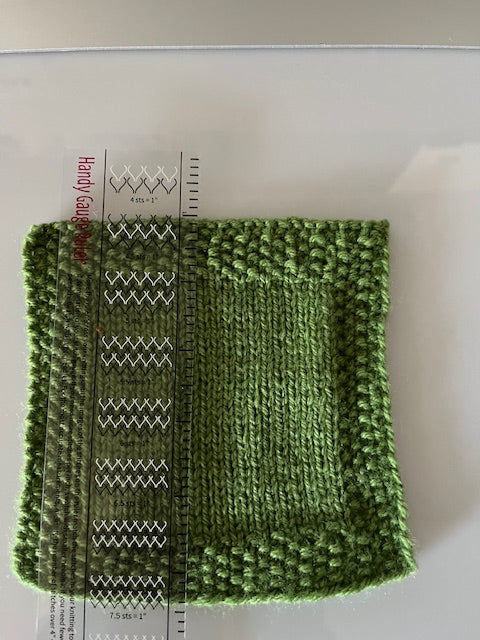This is a very old blog post, but one that is always timely so I will share it again
Knitting a swatch and checking the gauge is of utmost importance to the fit of your garment as well as the quantity of yarn needed for your project. However, the gauge on the label is only a starting point; differences in knitting or crocheting tension, the type of fiber, the ply or twist, and the fabric you prefer will affect which yarn you choose. The gauge on the label will give you an indication if the yarn will be an appropriate choice. So please read on !
***************************************************************************************
A few of us were sitting around the table at the shop and one was making a swatch and commented, I almost never have to change needle size. I always knit to gauge. So I asked all the usual questions – to whose gauge do you think you are knitting ? You do know that if you and I used the same yarn and needles that we would very well knit at a different tension. Different needles can affect your gauge – yada yada yada. Then I asked, did you ever wonder how the “suggested” gauge on labels is determined ? Are swatches made on machines ? Is there a formula for yarn weights ? Does someone actually knit a swatch ??? Sometimes I think customers think I’m crazy when I say knit a swatch with a few needle sizes and use the fabric you like – especially when making a garment where fit isn’t paramount. I will knit a swatch with a row of eyelets or purl sts corresponding to the needle size in use, making a new row as I change needles.
Well, the only way to get an answer to my question was to go the the pros – JoAnne Turcotte, design director at The Plymouth Yarn Co. and Norah Gaughan, design director at Berroco, Inc.
JoAnne knits all the swatches herself to determine the gauge on the ball bands. This maintains consistency. All of the gauges on Plymouth labels are from her swatches EXCEPT Encore and Fantasy Naturale, which if SHE knit them, would be different !! Both of those yarns were gauged before she was there.
This is what Norah said :
“We try to maintain consistency by having one person determine the gauge, but at least three of us knit swatches and often none of them match exactly. Different yarns bring out the differences in knitters too. If a yarn has a lot of stretch we see more variance between my gauge and the woman whose gauge we use on the label. Also, over the years a change in design directors means a change in the type of fabric determined to be the best gauge. For instance I like a tighter fabric than my predecessor.”
What does all of this mean ? A gauge & needle size on a label is SUGGESTED only. You may need to adjust needle size to obtain that gauge, IF you even like the fabric knit (or crocheted ) at that gauge. Also, if you are substituting yarns, a yarn with a slightly different suggested gauge MAY work. If you are making a garment from a pattern that needs a specific gauge to fit properly, then you MUST make a gauge swatch. As Norah said, “I think the ball band gauge and needle size should be used as a suggestion only and that you should always knit, wash and block the swatch or be prepared to rip out later. ” Even though I am a yarn shop owner and pay my bills by selling yarn, it is a good investment for the customer to buy a skein of one or two yarns to swatch with for that important sweater project !
So PLEASE don’t say to me I knit to gauge. The stitches/inch is a FABRIC to be achieved and which needles/hooks (yes this applies to crochet, too) you use to knit this fabric can vary from person to person.
